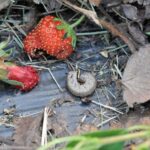After a long cold winter under protection, nothing signals spring like the first blooms on strawberry. ‘Tis the season in our high tunnels and thus time to provide a few reminders/updates on how to protect the development of these early fruits from insect pests. The first thing you want to do is examine the health of your plants. Are there pests that have hidden under the winter protection and found a home on your crop? The most common culprits are aphids and spider mites (Figs. 2 and 3). Getting these populations under control before the weather warms is crucial to prevent large pest outbreaks that reduce plant productivity.
Pruning the plants to the crown is effective in reducing aphid and spider mite populations (inoculum) that persist in the winter (Fig 1). Strawberry will send out new growth in the spring. Reducing this initial inoculum can slow down pest population increase and help with spring pest management.
To scout for aphids and spider mites, observe 30 strawberry leaflets from random locations of the planting under a hand lens (if available) or with the naked eye to scout for pests. If pest densities are low (between 1-5 individuals per leaflet on average) it is recommended to release natural enemies (predatory mites, Orius or lacewing larvae) onto the pruned crop to keep pest populations low. “Hotspots” can also be observed for aphids (sticky residue associated with sooty mold and white shed exoskeletons; Fig 2C) and spider mites (stippling damage to leaves; Fig 3B) and natural enemy introductions should be concentrated in these areas. After natural enemies are released, take weekly leaf collections using the technique above to determine if the pest population is growing, staying low, or reducing in size.
If your initial pest density from above was high (i.e., above 5 individuals per leaflet on average), or if pest populations are increasing several weeks after natural enemy introductions, you may want to consider applying a quicker acting insecticide to knock down pest populations to a more manageable level. Flonicamid is an active ingredient that targets piercing-sucking insects and is very effective. Other options include insecticidal soaps or oils. Depending on the post-harvest interval, natural enemies can be released onto strawberry plants that have been sprayed to clean up any surviving pests and to maintain low pest densities.
The next thing is to protect those early setting flowers, from both insect pests. There are a few insect pests that target feeding on the flowers, leading to damaged/misshapen fruits. The most common of these is the tarnished plant bug. These are small, tan to black bugs that feed with piercing-sucking mouthparts. These pests can feed on all plant parts, but feeding damage to developing strawberry fruits can lead to small, distinctively misshapen fruit damage referred to as cat facing damage. Another abundant pest can include thrips, that preferentially feed on flowers and buds. Thrips are small and difficult to detect on plants, and are therefore easiest to monitor using sticky cards or by tapping bud or flower clusters over a piece of white paper or cup of water (Fig 4B). Dislodged individuals can be seen on this white background or in the water. This tapping method can also be used to scout for tarnished plant bug.
Other occasional pests include the strawberry bud weevil, caterpillars, slugs and variegated cutworms (Figs. 5-6). Keeping the fruit off the soil can help minimize damage by slugs and cutworms as well as reducing the among of organic matter decomposing on the soil surface, which the slugs and cutworms take refuge in.
For the most recent recommendations for strawberry production see the Midwest Fruit Pest Management Guide found here.
- Fig 1. Before (A) and after (B) pruning on Feb. 20. Plants were actively blooming on Mar 20 (C). The trial was conducted in a high tunnel at the Southwest Purdue Ag Center, in Vincennes, IN.
- Fig 2. Aphids on a developing strawberry fruit(A) and on the underside of leaves (B). C shows an aphid hotspot on spinach, showing a sticky residue and white aphid exoskeleton that will be similar in appearance on strawberry. Photos by Wenjing Guan and Sam Willden.
- Fig 3. Twospotted spider mites on strawberry leaves (A) and damage on strawberry (B). Photos Sam Willden.
- Fig 4. Thrips adult and nymph (A) and flower tapping method (B). Photos by John Obermeyer and Sam Willden.
- Fig 5. Slug feeding on strawberry fruit. Photo by John Obermeyer.
- Fig 6. Variegated cutworm next to damaged strawberry. Photo by John Obermeyer.





